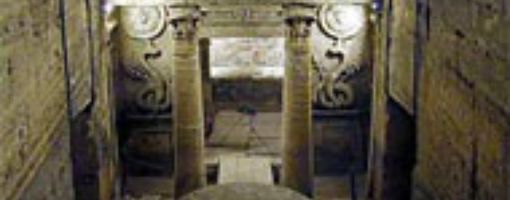EGYPTIAN RELIGION

The almost infinite varieties of representation of the numerousdivinities which have been found in ancient Egyptian monuments have led to agross misunderstanding about the religion of the Ancient Egyptians. Thereligion of ancient Egypt which one is tempted to think of as polytheistic, wasin fact, like all the great religions, monotheistic. Today scholars are agreedthat the many divinities found in Egyptian temples are to be considered asattributes or intermediaries of the Supreme Being, the One God, the only onerecognized and worshipped by the priests, those initiates or wise men of thesanctuaries. At the pinnacle of the Egyptian pantheon there stands a Godwho is unique, immortal, who was not created, and who is invisible andhidden in the inaccessible depths of his own Being. Begot by himself from alleternity he absorbs in himself all divine characteristics. It was not godsthat were worshipped in Egypt but, under the name of whatsoever deity, thehidden God who has no name or form. A single idea dominated everything, that ofa God who is one and primordial.
The Egyptian priests defined him thus: « He who is begotten fromhimself; the Principle of all life, the Father of fathers, the Mother of mothers» and they also said « From him comes the substance of all other gods » and « Itis by His will that the sun shines, that the earth is separated from thefirmament, and that harmony reigns on all creation ». However to make the beliefin the One God more understandable to the Egyptian people, the priests expressedhis attributes and his various roles by means of subtle representations.The most perfect image of God was the sun with its three attributes: shape,light and heat. The sun's soul was called Amon or Amon-Ra, a name which means «hidden-sun ». He is the father of life and the other divinities are only thedifferent parts of his body. We can now introduce the famous Egyptian triads. Adthe masters of this ancient theology tell us the Supreme Being, the creator of the universe, is unique in his beingbut not in his person.
Hedoes not come out of himself to beget but the begets within himself. He is atone and the same time the Father, the Mother and the Son of God without leavingGod. These three persons are « God in God » and far from destroying the unity ofthe divine nature together they engender his infinite perfection. The Fatherrepresents creative power while the Son, image of the Father, strengthens andmanifests his eternal attributes. Every Egyptian province had its own triad, allinterrelated, but this more compromised the divine unity than the divisionof Egypt into provinces compromised the unity of the central government. Theprincipal or great triad was that of Abydos which consisted of Osiris, Isis andHorus. It was the most popular and was worshipped throughout Egypt becauseOsiris personified Good and was popularly known as the « good God ».
The triad at Memphis consisted of Ptah, Sakh-met and Nefer-Tum, that atThebes of Amon, Mut and Khonsu. The Trinity was not the only dogma which Egypthad retained from primitive revelation. In the holy books one also findsoriginal sin, the promise of a redeeming God, future restorations of humanity,and the resurrection of the flesh at the end of time. At each change of dynastythere was a monotheistic revolution and the Supreme Being prevailed overthe fetishism of the other divinities. The religious revolution of Akhnatonhad been preceded by that of Menes, not to mention that of Osiris (5thmillennium B.C.). According to some historians during the reign of Osiris,king of Thebes, (4200 B.C.) a complete change in religionoccurred.
This king, the most devout of all, succeeded in getting monotheismadopted on a wide scale. It was this same Osiris, defied, who reigned over theSupreme Court for the judgment of the souls of the dead. According to the riteof « psychostatis » (meaning « weighing of the soul », i.e. the ceremony offinal judgment of the deceased), the soul of the dead person was carried ona sacred barge over the waters of the Elysian Fields. As the barge passed itbrought light to those regions inhabited by the souls of the damned who trembledwith joy at the sight of a little of that light which was now denied to them.The barge continued its journey and after crossing a lighter zone,corresponding more or less to our purgatory, finally reached the Supreme Courtpresided over by Osiris and his forty two assessors. The heart of the deadperson was placed in one pan of a balance while in the other was placed afeather, symbol of the goddess Maat. If the dead person had done more good thanevil then they became one of the « true of voice » and thus a part of themystical body of the god Osiris. If this was not so the heart was eaten by ananimal with the head of a crocodile and the body of a hippopotamus and ceased toexist in the Other World. A soul which had thus been « justified » was thenadmitted to Ialou, the Elysian Fields.
Atthis point one may well ask why so many everyday objects are found in thepyramids and tombs. It should not be forgotten that the fundamental religiousidea of the Ancient Egyptians was that human life continued even after physicaldeath. But only those who continued to enjoy what they had enjoyed in thelife could attain the Other World. Hence the house furnishings, the food, thedrink, the servants and the other objects necessary to everydaylife.
SACREDANIMALS
Toour eyes the monotheism of the all Ancient Egyptian religion has all theappearances of fetishism. However it should be recognized that the innumerablegods of the Egyptian pantheon are nothing more than manifestations of theSupreme Being in his different roles, agents or representations of the eternalaspect of the divinity. This is the meaning which must be attached to thecult of the sun, of the earth, even of certain animals, which one finds indifferent provinces of Egypt. Indeed it was only at a relatively late periodthat the Egyptian gods assumed a human appearance, initially they incarnatedplants and animals. The goddess Hathor lived in a sycamore tree; the goddessNeith who gave birth while remaining a virgin and whom the Greeks identifiedwith Athena was worshipped in the shape of a shield with two crossedarrows. Nefertum (identified in Prometheus) went under the form of a lotusflower.
Your Rating:
Overall rating: 0.000
Totally voted: 0
Comments
Weather in:
Exchange Rates
-
IMF loan expected next month
Apr 22, 2013, rating: 3.000, 3 votes Egypt may secure an International Monetary Fund loan agreement in about amonth, state news agency MENA reported, quoting "informed" sources ...
Egypt may secure an International Monetary Fund loan agreement in about amonth, state news agency MENA reported, quoting "informed" sources ...
-
Egypt received 11 million tourists in 2012 and aims to boost that number to 14 million in 2013.
Jan 22, 2013, rating: 3.000, 2 votes
Egypt received 11 million tourists in 2012 and aims to boost that number to 14 million in 2013.
-
Egypt limits travelers leaving country to US$10,000 in cash
Dec 26, 2012, rating: 3.250, 4 votes Egypt has banned travelers from carrying more than US$10,000 in foreigncurrency cash in or out of the country ...
Egypt has banned travelers from carrying more than US$10,000 in foreigncurrency cash in or out of the country ...
-
National Coalition on Climate Change for Egypt is born
Nov 30, 2012, rating: 5.000, 1 votes The global COP18 conference on climate change opens in Doha Monday.About 17,000 participants from all over the world ...
The global COP18 conference on climate change opens in Doha Monday.About 17,000 participants from all over the world ...
-
Judgment for sexual harassment
Nov 14, 2012, rating: 3.600, 5 votes A man was sentenced to two years in prison and fined LE 2,000 for sexually harassing a woman, an ...
A man was sentenced to two years in prison and fined LE 2,000 for sexually harassing a woman, an ...
-
Scientists are enthusiastic about hydrogen's green applications
Nov 13, 2012, rating: 4.000, 3 votes
As fossil fuel reserves decrease, many countries are turning to hydrogen as one of the main sources of alternative energy ...








